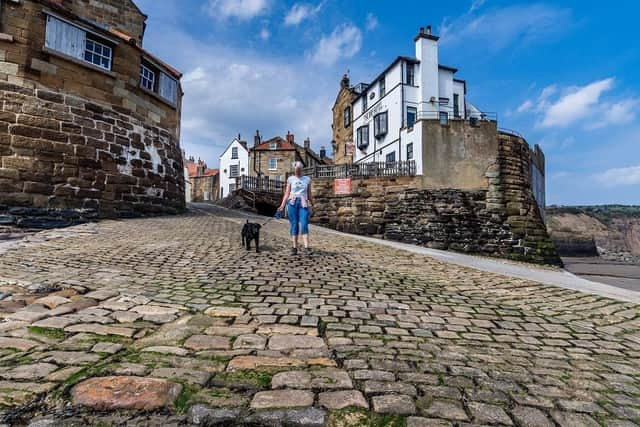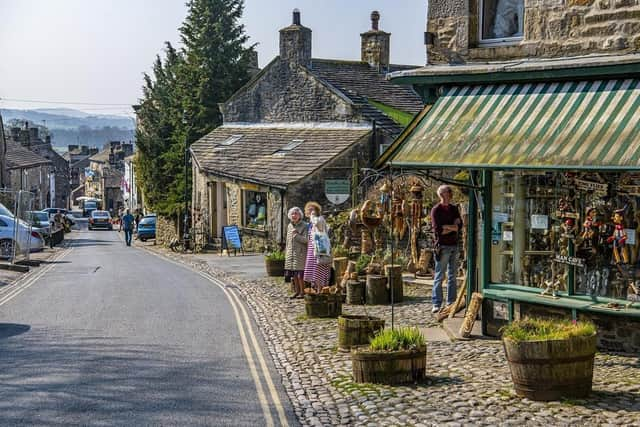Yorkshire's oldest villages and the history behind them including one that inspired Bram Stoker’s Dracula and another where Channel 5 series All Creatures Great and Small was filmed
It is thought that the region was first occupied following the ice age around 8,000BC. Romans, Angles and Vikings were living here during the first millennium AD.
The name derives from ‘Eborakon’ which is an old Brythonic name meaning ‘the place of the yew-trees’. Ancient Yorkshire dialect and terms come from the old Norse which is influenced by Vikings.
Advertisement
Hide AdAdvertisement
Hide AdThe name ‘Yorkshire’ was first referenced in writing in the Anglo-Saxon Chronicle in 1065. The Norman Conquest led to the establishment of various villages, below are some of the oldest along with their individual histories.


Oldest villages in Yorkshire and the history behind them
Wharram Percy
While the land may have existed since prehistory, it is thought that the village first had settlers from the 10th to the 12th centuries and it was first mentioned in the Domesday Book of 1086 as ‘Warran’ or ‘Warron’. During the Middle Ages, an aristocratic family owned the area and added the suffix ‘Percy’.
Wharram Percy saw a steep decline in its population following the Black Death between 1348 and 1349 which may have encouraged residents to relocate to larger settlements.


The Percy family swapped their holdings in the area with the Hylton family in either 1402 or 1403. Pastoral farming became more popular and profitable during the 15th century, so the Hylton family dedicated more land to sheep, as their employment of agricultural labour declined.
Advertisement
Hide AdAdvertisement
Hide AdTo make more room for sheep, the latest residents of Wharram Percy were evicted and their homes were demolished during the 16th century.
The site is now owned by Historic England.
Robin Hood’s Bay
By the year 1000 the hamlet of Raw, which bordered the present-day Robin Hood’s Bay, and the village of Thorpe (Fylingthorpe) in Fylingdales had been settled by Norwegians and North Germanic peoples (Danes).
Following the Norman conquest in 1069 most of the land in Northern England, including Fylingdales, was laid waste.
Fylingdales was passed to Tancred the Fleming by William the Conqueror, who later sold it to the Abbot of Whitby.
Advertisement
Hide AdAdvertisement
Hide AdThe first reference to Robin Hood’s Bay is thought to have been in the period between 1324 and 1346, when Louis I, Count of Flanders, wrote a letter to King Edward III where he complained that Flemish fishermen along with their boats and catches were forcibly taken to ‘Robyn Oeds Bay’.
After the Dissolution of the Monasteries in 1540, Whitby Abbey and its lands became the property of King Henry VIII with King Street and King’s Beck that dates back to this time.
Robin Hood’s Bay was initially considered the main port above Whitby in the 16th century and is described by a tiny picture of tall houses and an anchor on old North Sea charts published by Waghenaer in 1586 and now in Rotterdam’s Maritime Museum.
The village has a history and tradition of smuggling, the illegal transportation of objects or substances, and comprises a maze of tiny streets as well as an alleged network of subterranean passageways linking the houses.
Advertisement
Hide AdAdvertisement
Hide AdDuring the late 18th century, vessels from the continent were pulled in with contraband which was distributed by contacts on land and the operations were financed by syndicates who profited without the risks taken by the seamen and the villagers. Contraband included tea, gin, rum, brandy and tobacco, which were smuggled into Yorkshire from the Netherlands and France.
Fishing and farming were the original occupations and many of the houses in the village were built between 1650 and 1750 and whole families were involved in the fishing industry.
Various families owned or partly-owned cobles, later some owned ocean-going craft and fishing had reached its peak in popularity in the mid 19th century, where fishermen used the coble for line fishing in winter and a bigger boat for herring fishing.
In 1897, Bram Stoker was inspired by his trip to Robin Hood’s Bay to set the scene of his book Dracula in the village. Abraham visited the area recreating the steep steps.
Advertisement
Hide AdAdvertisement
Hide AdThe village was also the setting for the Bramblewick novels (Three Fevers, Phantom Lobster, Foreigners, Sally Lunn, Master Mariner and Sound of the Sea) by Leo Walmsley.
More recently, Robin Hood’s Bay was the filming location for 2008 film Wild Child starring Emma Roberts and Natasha Richardson and the 2017 film Phantom Thread starring Daniel Day-Lewis.
Grassington
The Domesday Book referenced Grassington as part of the estate of Gamal Barn that encompasses Grassington, Linton and Threshfield.
The Norman conquest made it part of the lands of Gilbert Tison, though by 1118, he had been demoted and his lands were returned to the king before being passed on to Lord Percy.
Advertisement
Hide AdAdvertisement
Hide AdIt was originally a settlement and spelt as Gherinstone; it was also documented as Garsington or Gersington.
The present name Grassington derives from the Scandinavian, Anglo-Saxon and Gothic languages, and means either the town of the grassy ings or a farmstead surrounded by grass.
Grassington was granted a Royal Charter for a market and fair in 1282 giving it a market town status and the market was held regularly until around 1860. But locals consider it to be a village.
Lead mining became more popular and increased financial demand resulted in a change in land use from the early 17th century. But Grassington's prosperity and popularity officially began during the late 18th and early 19th centuries. The Yorkshire Dales Railway to Threshfield opened in 1902 and brought in new visitors, many of whom settled there, found work in Skipton or in the limestone quarries.
Advertisement
Hide AdAdvertisement
Hide AdThe Old Hall is thought to be the oldest house in Yorkshire as it dates back to the late 13th century or early 14th century. Grassington Town Hall was completed in 1855.
Grassington was used as the setting for the fictional town of Darrowby in the 2020 Channel 5 series All Creatures Great and Small.
Levisham
Levisham is recorded as a tiny settlement in the Domesday Book of 1066 and the name of the village was initially referenced as Leuecen which derives from Old Norse, meaning the farmstead of Leofgeat’s people.
The Black Death in the 14th century is thought to have resulted in a relocation of the village and the Church of St Mary, a grade II-listed building dating back to the 11th century, is now isolated from the current village. It is thought to mark the site of a Deserted Medieval Village.
Advertisement
Hide AdAdvertisement
Hide AdBetween 1974 and 2023 the village was part of the district of Ryedale.
It was used as a filming location for the 2023 film Mission: Impossible - Dead Reckoning Part One starring Tom Cruise, Hayley Atwell, Simon Pegg, Rebecca Ferguson and Vanessa Kirby.
Appleton-le-Moors
This village is recorded in the Domesday Book and maintains its authentic medieval layout. It is a site of archaeological interest as it is rich in source finds such as flint tools, Roman coins and a medieval oven.
The church and village hall, which used to be a school, were built by Mary Shepherd in the 19th century, widow of Joseph Shepherd who was born in the village, who went to sea and became a shipowner and very rich.
During the 1980s and 1990s the house was transformed into a country hotel and has since returned to its original purpose as a private residence.
Comment Guidelines
National World encourages reader discussion on our stories. User feedback, insights and back-and-forth exchanges add a rich layer of context to reporting. Please review our Community Guidelines before commenting.
